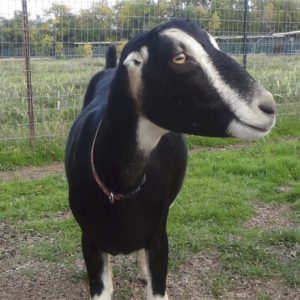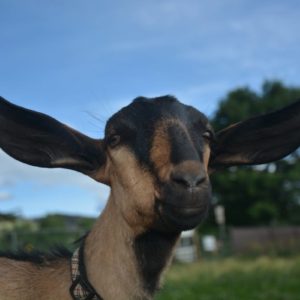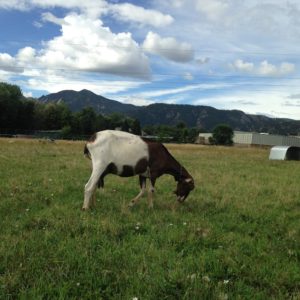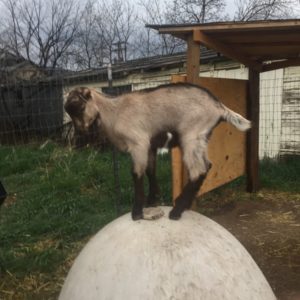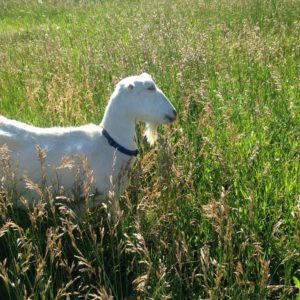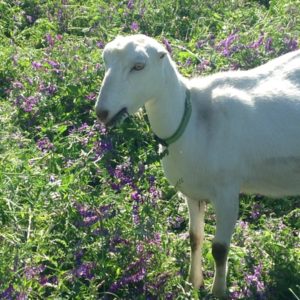We currently have 11 goats in our herd and you can learn about each of them below. Use the following controls to filter the list by breed, gender, or birth year, or select a nickname to go directly to a goat biography.
Goats are part of the genus Capra and are thought to have originated in the mountainous regions of western Asia and eastern Europe (the near east). Around 11,000 years ago, goats were the first wild herbivores to be domesticated. They helped to transform humans from hunter-gatherers to a more advanced agricultural based society. Goats were kept in small herds and were used for their milk, meat, coats for clothing and housing, and dung for fuel. Goats were so important to ancient humans they looked to the stars and created the Zodiacal constellation of Capricorn.
Read more...Goats are browsers which means that they eat tree leaves, twigs, green stems from plants, vines, weeds, and woody plants like shrubs. They are more like deer, who are also browsers, than like cows and sheep who graze on grass. Goats are ruminants and have a four chambered stomach. These four chambers give the goats the ability to eat a large amount of food, then regurgitate the partially chewed food, called cud, and chew it again to break it down to make it easier to digest. This system allows goats to extract nutrition from low-quality food. At Growing Gardens, our goats are fed high quality alfalfa and grass (purchased from local farms), pasture offerings, and organic grains from Fehringer Farms in Nebraska.
One of the most interesting features of goats are their eyes. They have rectangular, horizontal pupils which are shared with sheep, octopuses, and toads. A goat’s unusual pupils allow them greater depth perception and excellent peripheral vision. Goats are a prey animal and their very effective pupils allow them to evade predators in a rugged terrain.
Most goats breed once a year. Interestingly, they show interest in breeding as the days get shorter in late summer and fall. Goats are influenced in breeding by the cycles of our Sun. At Growing Gardens, we respect this natural cycle and breed our goats in mid-autumn. A doe will carry her unborn kids for approximately 150 days (five months) so our kids are born in March or April. It is common for a doe to give birth to twins – but one kid or triplets are not unheard of. Initially, the kids are fed their mother’s milk and the does are not milked. After a couple of weeks, the does are producing milk for human consumption and feeding their kids.
The most wonderful thing about goats is that they are very social animals. Goats love human attention. They enjoy being hugged, pet, brushed, and sitting in your lap. Goats do like to be pet – but not on the top of their head. This is because, although they can see almost 360 degrees around (thanks to their unusual pupils), they cannot see above them very well. Show them your hand from the front and side before you pet them. Then pet their neck, back, and chest. Some goats do like having their head scratched once they feel comfortable with you. They are playful, curious, and incredibly intelligent. Our goats at Growing Gardens look forward to visiting with you.
Does are female goats that are at least one year old.
Doelings are female goats younger than one year.
Bucks are intact male goats that are at least one year old and used for breeding.
Bucklings are intact male goats younger than one year.
Wethers are neutered male goats that are at least one year old.
Young Wethers are neutered male goats younger than one year.
Alpine goats are European Mountain Goats that descend from the Persian (Middle Eastern) Pashang goat. They were named for their home mountain range, the Alps. Alpine goats have a coat that is short, sleek, and fine and show in an extensive variety of colors and patterns. Their most unusual feature is their long, upright ears not seen on any other goat breed. Alpine goats are extremely agile and have an excellent sense of balance to manage on steep mountain slopes – hence they make outstanding pack goats. They are hardy, friendly, and independent. Alpine goats are superior milk producers. Their milk is high in both protein and butterfat (~3.5%). Alpine goats are seasonal breeders.
Cashmere goats originate from wild Kashmiri goats found in the Himalaya Mountains. Their name, though spelled differently, originates from Kashmir – a region located in the very northwest part of India bordered by Pakistan, China, and Tibet. Interestingly, cashmere goats are considered a type – not a breed. There is no such thing as a purebred Cashmere goat so they can look very different from one another. Cashmere goats produce two coats. The top coat is called guard hair which is long, coarse, and straight. It is the downy undercoat that is in worldwide demand. Cashmere wool is very soft, warmer than sheep wool, and is considered one of the world’s premium fibers. Cashmere goats are intelligent, gentle, and personable.
Golden Guernsey dairy goats are a rare breed in the United States. Their origin is not known with certainty, but the Golden Guernsey are common on the Island of Guernsey, one of the Channel Islands, and the mainland of Britain. Golden Guernsey goats are medium in size and are best known for their beautiful gold coats. Their coats are shades of gold, ranging from very pale flaxen cream to honey, deep russet, or bronze. Their ears are erect and point forward with a slight upturn at the tips. The Golden Guernsey goats are docile, well-mannered, and very social. Their milk is sweet and butterfat percentages are usually 6% to 8%. They are excellent milk producers for their size.
LaMancha goats are recognized as a North American breed. This breed is thought to have descended from Spanish short-eared goats brought by early settlers to California. LaMancha goats have short, glossy coats and show in many different colors and patterns. LaMancha goats are distinctive because it first appears as if they have no ears. They do have short ears which occur in two types: the “gopher ear” which has no fold and does not exceed one inch and the “elf ear” which turns up or down at the end of the ear and does not exceed two inches. These goats are inquisitive, cooperative, and very sweet. LaMancha goats are good milkers and produce milk with a high butterfat content (~4.2%). LaMancha goats are seasonal breeders.
Nigerian Dwarf goats trace their origins to West Africa – most probably to a goat known as a West African Dwarf. They are considered to be a miniature dairy goat breed and, although smaller than other dairy goats, have beautifully balanced proportions. Nigerian Dwarfs have short to medium, soft coats and have upright, medium length ears. They show with a beautiful array of colors and markings. Nigerian Dwarfs are calm, gentle, curious, and playful. Their kind personalities and manageable size make them popular as pets and companions for children, the disabled, and the elderly. Nigerian Dwarfs are known for their high quality milk with exceptionally high butterfat content (6-7%). Nigerian Dwarf goats breed year round.
Nubian goats acquire their name from the Nubian desert in northeast Africa. However, present day Nubians (Anglo-Nubians) originate from a mix of English goats and exotic long eared goats from Africa, India, and the Middle East. Nubian goats are easy to recognize due to their long ears and their convex facial profile making them look very aristocratic. They have a short, glossy coat, and show in a variety of colors and patterns. Nubian goats can be very vocal (they make a distinctive, low-pitched “maaa-aaa” sound), opinionated, and stubborn. They are also smart, gentle, and loving. Nubian goats produce less milk than other breeds, but their milk tends to be higher in protein and butterfat content (~5%). Their milk is sweet and is ideal for making cheese, yogurt, and soap. Nubian goats can be either seasonal or year-round breeders.
Crossbreed goats are goats whose dam and sire are of different breeds. At Growing Gardens, for example, we have bred LaMancha goats with Alpine goats resulting in beautiful, healthy offspring with unusual ears.

